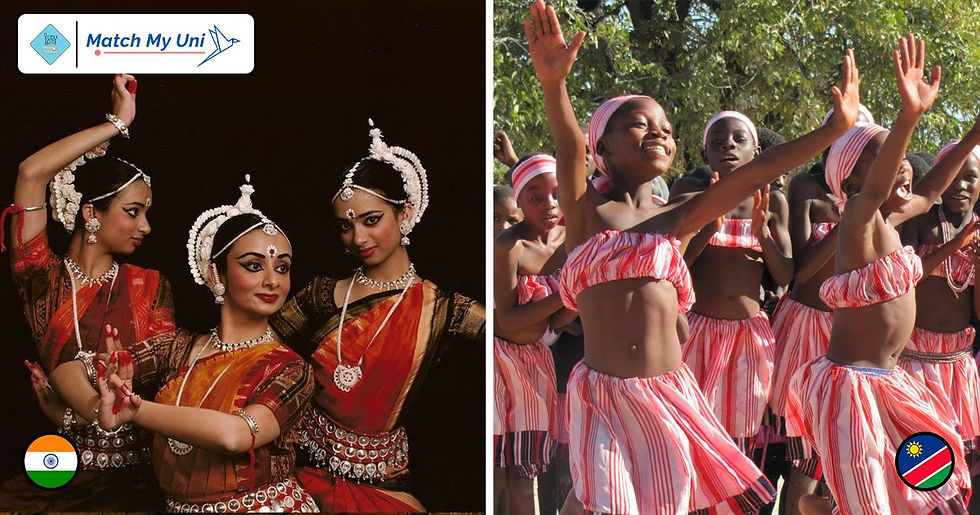Top 7 Cultural Customs That Bring Namibia and India Together
- Deepshikha
- May 16, 2024
- 3 min read
Introduction

India and Namibia are distant from one another, yet they are bound together by a rich cultural fabric of mutual respect and affection for others. From customary celebrations to delicious food, both countries highlight a unique blend of togetherness and variety. In order to illustrate the common values and traditions between Namibia and India, we are going to study 7 unique ways of life.
1. Customary Clothes and Accessories

Namibia is known for its colourful traditional clothing, which reflects the country's many ethnic groups, including the Herero, Himba, and Ovambo. Similar to this, India's traditional attire, such as kurta-pajamas, dhotis, and sarees, symbolises the rich cultural legacy of the nation. Both countries are very proud of their traditional clothes, which they frequently wear to celebrations, marriages, and other important occasions.
2. Festivities of Celebration

Both Indian and Namibian customs have their origins in festivals, which are times of happiness, togetherness, and religious importance. While India is well-known for its various holidays like Diwali, Holi, and Eid, Namibia celebrates festivals such as the Windhoek Karneval and the Himba Festival. These festivities cross boundaries and promote mutual joy and interaction between cultures.
3. Delicious Treats From India & Namibia

People from Namibia and India have a particular affection for food, and both have rich culinary traditions. While Indian cuisine offers an exciting options of tastes, spices, and regional specialties like biryani, dosas, and samosas, Namibian cuisine includes the basis such as kapana (grilled meat), mopane worms, and mahangu porridge. The food friendship between these countries is highlighted by their mutual love of tasty cuisine.
4. Dance and Music

Namibian and Indian cultures are beautifully represented through dance and music. Namibian music is made up of numerous styles, such as modern Afro-pop and ancient tribal beats. In India, Bollywood-inspired shows exist together with traditional dances like Kathak and Bharatanatyam. The beautiful motions and steady beats of Indian and Namibian dance styles speak to a common love of creating something beautiful although their different styles.
5. Religion and Spiritual Practices

For many people in Namibia and India, spirituality is the main part of their lives, affecting their social standards, beliefs, and practices. Whereas India's spiritual landscape is represented by Hinduism, Islam, Sikhism, and other faiths, Namibia's indigenous communities follow Christianity, animistic beliefs, and ancestral worship. Both countries value various religions and encourage mutual respect and acceptance for those who hold different beliefs.
6. Communicating and Language

Language acts as an effective connection that promotes cultural exchange between India and Namibia. While Oshiwambo, Afrikaans, and English are among the many indigenous languages spoken in Namibia, India is well known for having a diverse range of languages spoken throughout the nation, including Hindi, Bengali, Tamil, and many more. Despite the differences in language, the maintenance of native tongues and the encouragement of multiple languages support the mutual cultural growth of these countries.
7. Customised and Handmade Items

The skill and artistry of Indian and Namibian craftspeople are an expression of long-standing customs that have been handed down through the ages. Ironwork, ceramics, and textiles are among the crafts of India; thoroughly connected containers, wooden artwork, and beautiful jewellery are among the crafts of Namibia. Craftspeople from both countries showcase their creativity on a worldwide platform and preserve their cultural heritage via their outstanding craftsmanship.
Conclusion
In conclusion, Namibia and India show a common culture that is defined by variation, strength, and unity, despite their differences in location. These cultures share a complex fabric of traditions and customs that range from traditional dress and delicious meals to music, dancing, and spirituality. Namibia and India are prime examples of the incredible beauty of different cultures and the effectiveness of diplomatic efforts based on culture because they have embraced their cultural history and promoted cross-cultural interactions.
Knowledgeable Guidance and International Study

Expert guidance is important to supporting students' goals of studying overseas. Edudite counsellors help students through the challenging process of applying to international colleges, getting scholarships, and adjusting to new learning environments by providing them with individualised guidance and support. Through the offering of useful knowledge on career pathways, standard of living, and educational prospects, Edudite allows students to make well-informed decisions on their overseas studies. To help students succeed academically, in their language, and globally, Edudite also provides many tools and programs that facilitate a seamless transition to studying abroad. Essentially, Edudite counselling acts as a source of guidance for students starting life-changing educational paths, giving them the skills and self-assurance they need to succeed in an increasingly interconnected society.

Comments